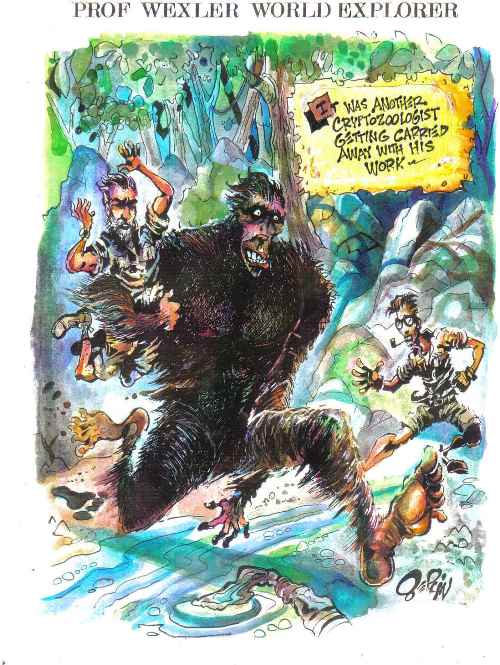
September 19, 2007

Yep, that’s me. Getting carried away with my passion for all things cryptozoological. I noticed today on the web that one of those “ask” sites had this question: “What are the different fields in Cryptozoology?”
This was their “Best Answer – Chosen By Voters” – to wit – “Cryptozoology is a branch of zoology; I have never heard of it being divided into ‘fields.'”
Darn. Yikes, they picked the wrong answer by internet consensus? Okay, I couldn’t let that remain unanswered more completely, so here’s my Cryptomundo-refined answer to the question of cryptozoological subfields.
+++
Cryptozoology, a sixty-year-old new subdiscipline of zoology, is divided into various subdivisions based on the type of cryptids (the unknown animals under pursuit) being studied. This division would follow closely that of the names of the cryptids. (“Cryptozoology” was coined by zoologist Ivan T. Sanderson in the early 1940s, and independently coined by zoologist Bernard Heuvelmans in the 1950s.)
Specifically, three of these cryptozoological subdivisions, for example, are:
1) Hominology – The study of hairy unknown hominoids refers to the research involving both cryptid hominids and cryptid pongids, known by names like Bigfoot, Sasquatch, Yeti, Yowie, Almas, and many others. Russian researcher Dmitri Bayanov coined the word “hominology” around 1973 in letters circulated among colleagues and then published in a Russian paper.
2) Draconology – The study of Lake Monsters is often used today to include the research on Sea Serpents and marine cryptids, but by strict definition, it applies only to Lake Monsters. It was coined by historian and diver Jacques Boisvert, a Quebec cryptozoologist. He was studying the cryptid (locally called Memphré) in Lake Memphrémagog on the Quebec-Vermont border. Boisvert consulted a monk at the monastery of St Benoit-du-Lac, asking for a term for the specific study of lake monsters, and draconology was born. (Some fantasy readers are upset because the word can also be seen to mean, “the study of dragons.”)
3) Cryptocetology – The study of cryptid cetaceans especially involves the booming research on sightings of ziphiids (beaked whales). This word was coined by French cryptozoologist Michel Raynal. He created it from cetology (the science of cetaceans) which already exists, and via adding the prefix “crypto.”
Updated information from Raynal confirms that in his correspondance with Bernard Heuvelmans, Raynal also used:
cryptoprimatology (primates),
cryptornithology (birds), and
cryptentomology (insects).
Various other subdivisions of cryptozoology exist, mostly based on the parameters of a search defined by what the animal reference points are for the alleged cryptids, but some divisions have also developed, historically, along geographic lines. For instance, a regional cryptozoologist might be interested in doing research on all Amazonian cryptozoology only.
Loren Coleman
+++
So, Cryptomundo readers, what are some of the other subdivisions of cryptozoology?
Thanks for the cartoon contribution to the blog by Charles Berlin, which I have posted again today on purpose, upon the occassion of his birthday.
About Loren Coleman
Loren Coleman is one of the world’s leading cryptozoologists, some say “the” leading living cryptozoologist. Certainly, he is acknowledged as the current living American researcher and writer who has most popularized cryptozoology in the late 20th and early 21st centuries.
Starting his fieldwork and investigations in 1960, after traveling and trekking extensively in pursuit of cryptozoological mysteries, Coleman began writing to share his experiences in 1969. An honorary member of Ivan T. Sanderson’s Society for the Investigation of the Unexplained in the 1970s, Coleman has been bestowed with similar honorary memberships of the North Idaho College Cryptozoology Club in 1983, and in subsequent years, that of the British Columbia Scientific Cryptozoology Club, CryptoSafari International, and other international organizations. He was also a Life Member and Benefactor of the International Society of Cryptozoology (now-defunct).
Loren Coleman’s daily blog, as a member of the Cryptomundo Team, served as an ongoing avenue of communication for the ever-growing body of cryptozoo news from 2005 through 2013. He returned as an infrequent contributor beginning Halloween week of 2015.
Coleman is the founder in 2003, and current director of the International Cryptozoology Museum in Portland, Maine.
Filed under Abominable Snowman, Alien Big Cats, Almas, Bigfoot, Breaking News, Cryptid Canids, Cryptomundo Exclusive, Cryptotourism, CryptoZoo News, Cryptozoologists, Cryptozoology, Homo floresiensis, Ivory-Billed Woodpecker, Lake Monsters, Living Dinosaurs, Lizard People, Loch Ness Monster, Malaysian Bigfoot, Men in Cryptozoology, Mystery Cats, New Species, Ogopogo, Pop Culture, Public Forum, Sasquatch, Sea Serpents, Skunk Apes, Swamp Monsters, Thunderbirds, Thylacine, Windigo, Women in Cryptozoology, Yeti